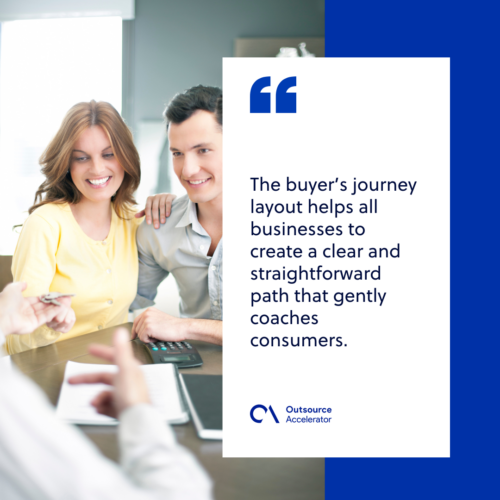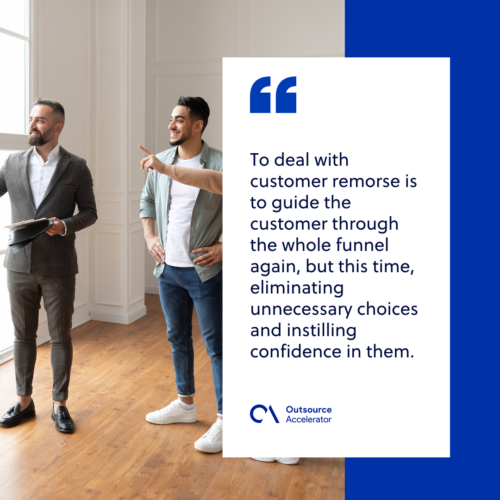Kickstarting your buyer’s journey in just 4 steps

The buyer’s journey layout helps all businesses to create a clear and straightforward path that gently coaches consumers. It also assists the marketing department to create more campaigns that will bring in more potential customers.
Kickstarting this funnel is a big endeavor for any company that sells products, goods, and services to the general public.
Defining the buyer’s journey
This is a funnel type of path that customers unconsciously follow whenever they’re purchasing something from a business. The funnel has three stages: Awareness, Consideration, and Decision.
In each stage, the customer makes micro-decisions to weigh in their choice if they’re going to purchase the product or not.

Awareness
The first stage happens when the customer has become aware that they have a problem or an issue that must be addressed and solved.
This aforementioned issue could be as simple as running out of household supplies to as complex as a problem with SEO software.
At this stage, the consumer will now actively seek out answers to their problems. This is where online and offline advertising comes into play.
If they see a product advertised as a solution, then they will consider it as a viable option, which now falls to the second stage.
Consideration
During this, the consumer has now done their research about the viable options that they came up with. But their search isn’t over yet, as they most likely need to narrow down their choices first.
This stage is crucial as they are weighing the pros and cons of each option they have right now. From price comparisons, reading other customer reviews, to researching the company to know more about the product.
From this moment forward, pricing, branding, and marketing strategies are on the hot seat.
Decision
This is the last stage of the funnel, wherein the customer will actively decide whether they will buy the product or not. Customer reviews are a big part of the decision that they will make.
By now, the consumer will try to narrow down their choices into one—picking out the best option there is.
- Fine-tuning content
Making content that is not only marketable and also relatable is one of the most effective ways to market products and services—helping customers discover your company.
- Finding the right marketing channel
In order for this step to work, businesses need to know what’s their most active social media channel. If their target audience is more active on Facebook, they can integrate Facebook online marketing right into their funnel.
- Analyzing new and past trends
By doing so, marketers can update and make subtle changes to their funnel manual in accordance with the trends.
- Utilizing call-to-action prompts
Catchy and short phrases that encourage readers to take action are referred to as call-to-action. These prompts are placed by the end of content with a link or on an interactive button if it’s on a digital platform.
Using CTA phrases will heighten the chance of customers browsing products and services and may even end up.
How the funnel can help customers decide better
The buyer journey funnel is designed not to coerce or force customers into buying a product or a service they don’t truly need. The funnel isn’t designed by a certain company but is catered to the general public.
Customers are able to make their own decisions and can freely choose between brands for their own good. The funnel is merely a guide for businesses to know which stage of the journey has pain points to acknowledge.
Is customer remorse part of the buyer’s journey?
Buyer’s remorse refers to the feeling of dejection and regret after purchasing a product or a service. Though it might seem negative, it is a very natural part of the buyer journey funnel.
Businesses train sales professionals on how to deal with customer remorse as customers are more likely to experience it when they make a big purchase.
How to deal with buyer’s remorse as a business owner
One of the reasons for the remorse is the lack of guidance when it comes to deciding whether to take the plunge or not.
Business owners and salespeople should always have a backup plan whenever the funnel hasn’t been completed or was totally abandoned.
To deal with customer remorse is to guide the customer through the whole funnel again, but this time, eliminating unnecessary choices and instilling confidence in them.

The importance of buyer’s journey
Each stage actively plays an important role in bringing in more customers and revenue into the company. As stated at the beginning of the article, the funnel assists both the consumer and the marketing and sales department of the company.
The marketing and sales department produces the output that the customer sees from their perspective.
Keep in mind that customers should always be able to make a decision without feeling forced, and that is why this journey encourages research and different buying choices.







 Independent
Independent




